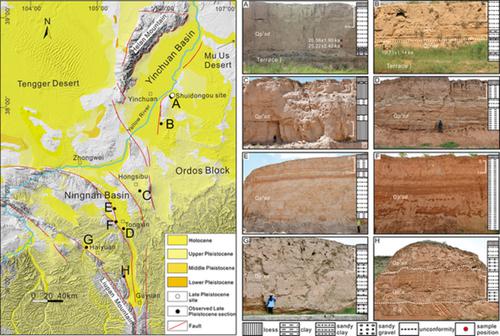当前位置:
X-MOL 学术
›
Geolog. J.
›
论文详情
Our official English website, www.x-mol.net, welcomes your
feedback! (Note: you will need to create a separate account there.)
Stratigraphy and its environmental implications of the Late Pleistocene Shuidonggou Formation in the western Ordos Block, North China
Geological Journal ( IF 1.4 ) Pub Date : 2020-08-31 , DOI: 10.1002/gj.3972 Xiaobo Liu 1, 2 , Jianmin Hu 2 , Wei Shi 2 , Hong Chen 2 , Xia Liang 2 , Mingtao Li 3, 4
Geological Journal ( IF 1.4 ) Pub Date : 2020-08-31 , DOI: 10.1002/gj.3972 Xiaobo Liu 1, 2 , Jianmin Hu 2 , Wei Shi 2 , Hong Chen 2 , Xia Liang 2 , Mingtao Li 3, 4
Affiliation

|
The Late Pleistocene sedimentary strata that is widely developed in North China records the signature of prehistoric human settlement. The Late Palaeolithic Shuidonggou Formation that is mainly distributed in the western Ordos Block of North China is best known for containing abundant palaeontological fossils and palaeolithic artefacts with an age span of ~35–20 ka B.P. However, its sequence and chronostratigraphy are poorly understood due to the lack of stratigraphic correlation of a uniform relative stratigraphy, hindering our understanding of the way of human adaptation to the environmental and climatic changes. In this article, analyses of high‐resolution stratigraphy of Shuidonggou Formation complemented with chronostratigraphic framework were performed based on our field investigations, Optically Stimulated Luminescence dating and literature survey, to reconstruct environmental and climatic conditions in western Ordos Block in the Late Pleistocene. Stratigraphic correlations and chronological evidence indicate that the sedimentary units of the Shuidonggou Formation are ~35–10 ka B.P. in age, and three lithologic units of Shuidonggou Formation that is well approximated on a regional basis were identified: gravel layers that were deposited in a fluvial environment at the bottom, rhythm layers consist of sand layers, and clay layers deposited in a lacustrine environment in the lower part, and cycles composed of lacustrine silt and loess in the upper part. These units are defined by sedimentology, matching to lake levels. Continuous and widely developed clay and sandy clay about 3–10 m thick occur at various levels within river terrace II and littoral deposits located 10–20 m above the current lake level provide evidence for the existence of the high lake level/palaeo‐lake in western Ordos Block between ~35 and 22 ka B.P. Palaeo‐lake shrinking occurred after when lakeshore sand and gravel, as well as sandy facies of aeolian origin, started to accumulate in the study area in 22–17 ka B.P. The development of the palaeo‐lake probably had been climate‐controlled since the warmer and humid climate conditions suggested by the lower sequences corresponds to the Marine Isotope Stage 3 while the cool and dry climate were identified in upper sequences corresponds to the Last Glaciation Maximum. Besides, the human occupation in the Shuidonggou site was synchronous with the development of the palaeo‐lake of the same time window. It is suggested that the evolution of the palaeo‐lakes in the Late Pleistocene, together with the environmental effects of climate change, play an important role in the human occupation and survival strategies.
中文翻译:

华北鄂尔多斯地块西部晚更新世水东沟组的地层学及其环境意义
华北地区广泛发育的晚更新世沉积地层记录了史前人类聚落的特征。晚老石器时代的水洞沟组主要分布在华北西部鄂尔多斯地块,最著名的是它含有丰富的古生物化石和旧石器时代的文物,年龄范围约为35–20 ka BP。然而,由于以下原因,人们对其年代和地层地层了解甚少缺乏统一的相对地层的地层相关性,阻碍了我们对人类适应环境和气候变化的方式的理解。本文在实地调查的基础上,对水东沟组高分辨率地层和年代地层框架进行了分析,光学激发发光测年和文献调查,以重建晚更新世西部鄂尔多斯地块的环境和气候条件。地层相关性和年代学证据表明,水东沟组的沉积单元年龄约为35-10 ka BP,并确定了在区域上很接近的水东沟组的三个岩性单元:砾石层沉积在河床中在底部的环境中,节奏层由沙层和沉积在下部湖泊环境中的粘土层组成,在上部由湖泊淤泥和黄土组成的循环。这些单位由沉积学定义,与湖泊水位相匹配。二阶河阶地内的不同高度上出现了约3–10 m厚的连续且广泛发育的黏土和砂质黏土,位于当前湖泊水平面以上10–20 m的沿海沉积物为该湖存在高湖泊水位/古湖提供了证据。在约35至22 ka BP之间的鄂尔多斯西部块体发生古湖收缩是在22-17 ka BP的研究区开始积聚湖岸的沙砾和风沙起源的砂岩相之后。湖泊可能是受气候控制的,因为较低层序所建议的温暖湿润的气候条件对应于海洋同位素第3阶段,而较高层序中所识别的凉爽和干燥的气候对应于最后冰川期。除了,水洞沟遗址的人类占领与同一时期古湖的发展同步。建议晚更新世的古湖演化以及气候变化对环境的影响在人类占领和生存策略中起着重要作用。
更新日期:2020-11-03
中文翻译:

华北鄂尔多斯地块西部晚更新世水东沟组的地层学及其环境意义
华北地区广泛发育的晚更新世沉积地层记录了史前人类聚落的特征。晚老石器时代的水洞沟组主要分布在华北西部鄂尔多斯地块,最著名的是它含有丰富的古生物化石和旧石器时代的文物,年龄范围约为35–20 ka BP。然而,由于以下原因,人们对其年代和地层地层了解甚少缺乏统一的相对地层的地层相关性,阻碍了我们对人类适应环境和气候变化的方式的理解。本文在实地调查的基础上,对水东沟组高分辨率地层和年代地层框架进行了分析,光学激发发光测年和文献调查,以重建晚更新世西部鄂尔多斯地块的环境和气候条件。地层相关性和年代学证据表明,水东沟组的沉积单元年龄约为35-10 ka BP,并确定了在区域上很接近的水东沟组的三个岩性单元:砾石层沉积在河床中在底部的环境中,节奏层由沙层和沉积在下部湖泊环境中的粘土层组成,在上部由湖泊淤泥和黄土组成的循环。这些单位由沉积学定义,与湖泊水位相匹配。二阶河阶地内的不同高度上出现了约3–10 m厚的连续且广泛发育的黏土和砂质黏土,位于当前湖泊水平面以上10–20 m的沿海沉积物为该湖存在高湖泊水位/古湖提供了证据。在约35至22 ka BP之间的鄂尔多斯西部块体发生古湖收缩是在22-17 ka BP的研究区开始积聚湖岸的沙砾和风沙起源的砂岩相之后。湖泊可能是受气候控制的,因为较低层序所建议的温暖湿润的气候条件对应于海洋同位素第3阶段,而较高层序中所识别的凉爽和干燥的气候对应于最后冰川期。除了,水洞沟遗址的人类占领与同一时期古湖的发展同步。建议晚更新世的古湖演化以及气候变化对环境的影响在人类占领和生存策略中起着重要作用。











































 京公网安备 11010802027423号
京公网安备 11010802027423号